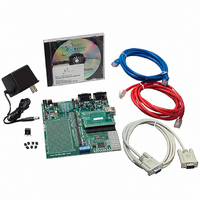NNDK-MOD5272-KIT NetBurner Inc, NNDK-MOD5272-KIT Datasheet - Page 297

NNDK-MOD5272-KIT
Manufacturer Part Number
NNDK-MOD5272-KIT
Description
KIT DEVELOP NETWORK FOR MOD5272
Manufacturer
NetBurner Inc
Series
ColdFire®r
Datasheets
1.MOD5272-100IR.pdf
(2 pages)
2.MOD5272-100IR.pdf
(550 pages)
3.NNDK-MOD5282-KIT.pdf
(2 pages)
Specifications of NNDK-MOD5272-KIT
Main Purpose
*
Embedded
*
Utilized Ic / Part
MOD5272
Primary Attributes
*
Secondary Attributes
*
Processor To Be Evaluated
MOD5272
Interface Type
RS-232, RS-485, USB
Lead Free Status / RoHS Status
Contains lead / RoHS non-compliant
Lead Free Status / RoHS Status
Lead free / RoHS Compliant, Contains lead / RoHS non-compliant
Other names
528-1001
- Current page: 297 of 550
- Download datasheet (6Mb)
Chapter 13
Physical Layer Interface Controller
(PLIC)
This chapter provides detailed information about the MCF5272’s physical layer interface
controller (PLIC), a module intended to support ISDN applications. The chapter begins
with a description of operation and a series of related block diagrams starting with a
high-level overview. Each successive diagram depicts progressively more internal detail.
The chapter then describes timing generation, the programming model, and concludes with
three application examples.
The reader is assumed to have a basic familiarity with ISDN technology and terminology.
A glossary containing many ISDN terms can be found on the web at the following URL:
http://www.tribecatech.com/isdnterm.htm.
13.1 Introduction
The physical layer interface controller (PLIC) allows the MCF5272 to connect at a physical
level with external CODECs (coder/decoder) and other peripheral devices that use either
the general circuit interface (GCI) or interchip digital link (IDL) physical layer protocols.
This module is primarily intended to facilitate designs that include ISDN (integrated
services digital network) interfaces.
The MCF5272 has four dedicated physical layer interface ports for connecting to external
ISDN transceivers, codecs, and other peripherals. There are three sets of pins for these
interfaces. Port 0 has its own dedicated set of pins. Ports 1, 2, and 3 share a set of pins.
Port 3 can also be configured to use a dedicated pin set. Ports 1, 2, and 3 always share the
same data clock (DCL).
When the ports are operated in slave mode, the PLIC can support a DCL frequency of
4.096 MHz and frame sync frequency (FSC/FSR) of 8 KHz. When in master mode, DCL
should be no greater than one-twentieth of the CPU clock (CLKIN), with a maximum
FSC/FSR of 8 KHz.
This chapter is written from the perspective of connecting to an ISDN transceiver with
8-KHz frame sync. The MCF5272 PLIC has four ports, port 0 – port 3, connected through
three pin sets, numbered 0, 1, and 3. A port can service, read, or write any 2B + D channel.
As shown in Figure 13-1, port 0 connects through pin set 0, and ports 1 and 2 both connect
MOTOROLA
Chapter 13. Physical Layer Interface Controller (PLIC)
13-1
Related parts for NNDK-MOD5272-KIT
Image
Part Number
Description
Manufacturer
Datasheet
Request
R

Part Number:
Description:
BOARD SERIAL-ETHERNET 512K FLASH
Manufacturer:
NetBurner Inc
Datasheet:

Part Number:
Description:
PROCESSOR MODULE FLASH MOD5272
Manufacturer:
NetBurner Inc
Datasheet:

Part Number:
Description:
PROCESSOR MODULE 512KB FLASH
Manufacturer:
NetBurner Inc
Datasheet:

Part Number:
Description:
DUAL PORT SERIAL-ETHERNET
Manufacturer:
NetBurner Inc
Datasheet:

Part Number:
Description:
PROCESSOR MODULE FLASH
Manufacturer:
NetBurner Inc
Datasheet:

Part Number:
Description:
PROCESSOR MODULE 512KB FLASH
Manufacturer:
NetBurner Inc
Datasheet:

Part Number:
Description:
MOD5234 10/100 ETHERNET MODULE
Manufacturer:
NetBurner Inc
Datasheet:

Part Number:
Description:
KIT DEVELOP NETWORK FOR MOD5282
Manufacturer:
NetBurner Inc
Datasheet:

Part Number:
Description:
DUAL PORT SERIAL-ETHERNET
Manufacturer:
NetBurner Inc
Datasheet:

Part Number:
Description:
Ethernet Modules & Development Tools 32 Bit 66MHz 40 Pin DIP Industrial Temp
Manufacturer:
NetBurner Inc
Datasheet:

Part Number:
Description:
Ethernet Modules & Development Tools MOD5213 DEVELOPMENT KIT
Manufacturer:
NetBurner Inc

Part Number:
Description:
Ethernet Modules & Development Tools DUAL PORT SERIAL EHTERNET DEVICE
Manufacturer:
NetBurner Inc
Datasheet:

Part Number:
Description:
Ethernet ICs 32bit 147MHz CAN-to- Ethnt Device IndTemp
Manufacturer:
NetBurner Inc
Datasheet:










